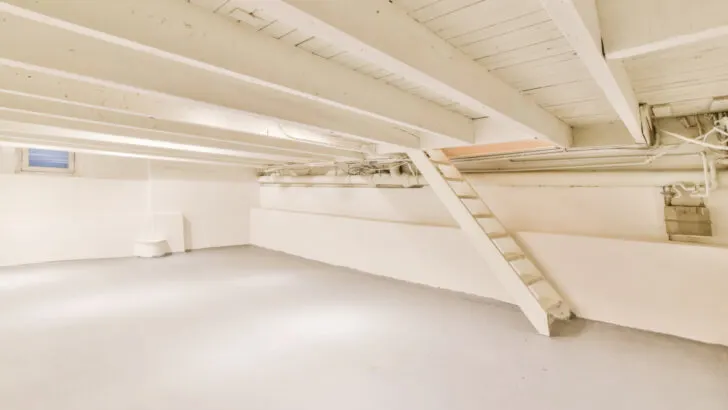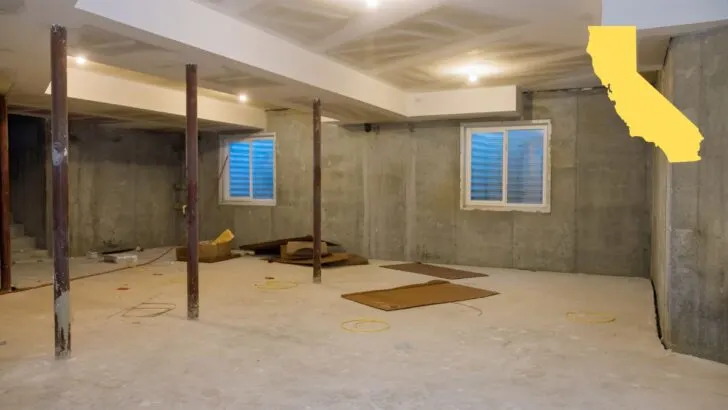Ever wondered why California homes rarely have basements? Delve into the unique factors and challenges that deter this architectural choice in the Golden State.
Let’s dig into the reasons below ground!
There are few basements in California due to several factors, including high water tables, seismic activity, and building codes. Basements can be difficult and expensive to construct in areas with high water tables, and seismic activity and building codes often require additional measures to be taken to ensure the safety and stability of a basement.
However, there is more to it… Keep reading to learn more about the reasons why there are very few basements in the state of California!
Table of Contents
Geological and Environmental Factors
Several geological and environmental factors contribute to the lack of basements in California homes.
The state’s unique climate and seismic activity are two major factors that make it difficult to build basements.
Additionally, the soil composition in many parts of California is not suitable for basement construction.
Seismic Activity
California is known for its frequent earthquakes, which can cause significant damage to buildings and infrastructure.
As a result, many homeowners and builders are hesitant to construct basements, which can be particularly vulnerable to earthquake damage.
In fact, the fear of earthquakes was often cited as a reason for the depth of basements in the Golden State.
Soil Composition
The soil composition in many parts of California is another factor that makes basement construction difficult.
According to the US Geological Survey, subsidence is a gradual settling or sudden sinking of the Earth’s surface due to the subsurface movement of Earth materials.
The main cause of subsidence in California is groundwater pumping. The effects of subsidence include damage to buildings and infrastructure, increased flood risk in low-lying areas, and lasting damage to groundwater.
This subsidence can make it difficult to build basements, as the shifting soil can cause structural damage to the foundation.
Furthermore, many areas in California have expansive soils, which can cause significant damage to foundations and other structural elements.
Expansive soils contain minerals that absorb water and expand, causing the soil to heave and shift. This can lead to foundation cracks and other structural damage, making it difficult to build basements.

Historical and Legal Factors
Several historical and legal factors have contributed to the lack of basements in California homes. This section will explore two of the primary factors: zoning laws and construction costs.
Zoning Laws
One of the reasons why basements are not common in California homes is due to zoning laws. In many areas of California, zoning laws restrict the amount of livable space that can be built on a lot.
This means that if a homeowner wants to add a basement to their home, they may be limited by zoning laws and unable to do so.
Additionally, zoning laws may require that a certain amount of open space is maintained on a property. This can limit the amount of space available for a basement, as it may be considered part of the livable space on the property.
Construction Costs
Another factor that has contributed to the lack of basements in California homes is construction costs.
Building a basement can be expensive, especially in areas where the soil is difficult to excavate. In California, the soil can be rocky, making it more difficult and expensive to dig a basement.
Furthermore, earthquakes are a common occurrence in California, and building a basement that can withstand seismic activity can add significant costs to the construction process.
This can make it less appealing for homeowners to invest in building a basement.
Cultural and Lifestyle Factors
Aside from the geological and climatic factors that affect the construction of houses in California, there are also cultural and lifestyle factors that contribute to the absence of basements in homes.
Home Design Trends
One of the main reasons why basements are not common in California homes is due to the design trends that emerged after World War II.
During this time, there was a housing boom in California that led to the fast development of homes. To speed up the construction process and maximize output, builders often excluded basements.
Additionally, California has a unique architectural style that emphasizes open floor plans and indoor-outdoor living.
Many homes feature large windows and sliding doors that blur the line between indoor and outdoor spaces.
With such an emphasis on outdoor living, homeowners may not see the need for a basement, which is typically a dark, enclosed space.
Outdoor Living
In California, the mild climate allows for year-round outdoor living. Many homes have patios, decks, and outdoor kitchens that serve as an extension of the indoor living space.
With so much time spent outdoors, homeowners may not feel the need for extra indoor space like a basement.
Moreover, California’s strict building codes require homes to have adequate natural light and ventilation. This means that basements would need to have windows or a ventilation system to meet these requirements, which can be costly and difficult to install.
Overall, the absence of basements in California homes is a result of a combination of factors, including geological, climatic, cultural, and lifestyle factors.
While basements may be common in other parts of the country, California’s unique circumstances make them less necessary and less practical for homeowners.

Alternative Basement Solutions
While basements are not common in California, there are alternative solutions that homeowners can consider for additional storage or living space.
Crawl Spaces
Crawl spaces are a popular alternative to basements in California. They are typically shallow spaces below the first floor of a home that provides access to plumbing, electrical, and HVAC systems.
They can also be used for storage but are not meant to be used as living spaces.
Crawl spaces can be ventilated or unventilated, depending on the climate and building code requirements. Ventilated crawl spaces allow air to circulate through the space, which can help prevent moisture buildup and mold growth.
Unventilated crawl spaces are sealed off from outside air and can be insulated to help regulate temperature and reduce energy costs.
Basement-Like Structures
Another alternative to basements in California is the use of basement-like structures that are built above ground.
These structures are typically made of concrete or steel and can be installed in a variety of locations, such as under a patio or in a backyard.
Basement-like structures can be used for a variety of purposes, such as a home office, gym, or storage space.
They can also be designed to blend in with the surrounding landscape, making them a great option for homeowners who want to maintain the aesthetic of their property.
One example of a basement-like structure is the “earth-sheltered” home, which is built into a hillside and covered with soil and vegetation.
This type of home can be energy-efficient and environmentally friendly, as the soil helps regulate temperature and provides natural insulation.
Final Words on Basements in California
In conclusion, California homes don’t typically have basements due to their history, climate, tradition, and cost.
However, nowadays, as more new houses are being built, basements are finally being included, and Californians are starting to appreciate basements more instead of just some storage space!
If you found this article helpful, make sure to take a look at some of my other posts linked below relating to basements!


